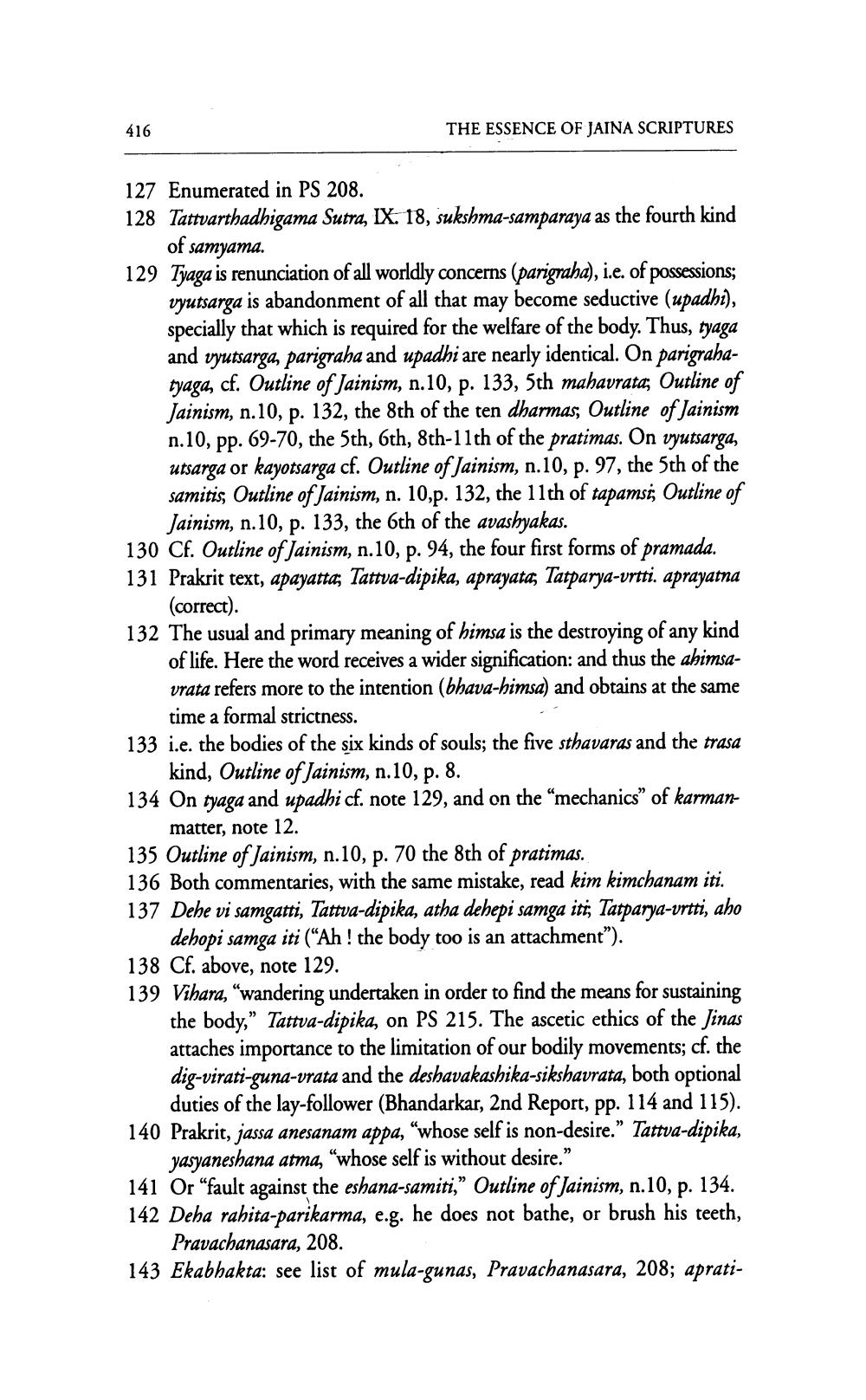________________
416
THE ESSENCE OF JAINA SCRIPTURES
127 Enumerated in PS 208. 128 Tattvarthadhigama Sutra, IX. 18, sukshma-samparaya as the fourth kind
of samyama. 129 Tyaga is renunciation of all worldly concerns (parigraha), i.e. of possessions;
vyutsarga is abandonment of all that may become seductive (upadhi), specially that which is required for the welfare of the body. Thus, tyaga and vyutsarga, parigraha and upadhi are nearly identical. On parigrahatyaga, cf. Outline of Jainism, n.10, p. 133, 5th mahavrata; Outline of Jainism, n.10, p. 132, the 8th of the ten dharmas, Outline of Jainism n.10, pp. 69-70, the 5th, 6th, 8th-11th of the pratimas. On vyutsarga, utsarga or kayotsarga cf. Outline of Jainism, n.10, p. 97, the 5th of the samitis, Outline of Jainism, n. 10,p. 132, the 11th of tapamsi; Outline of
Jainism, n.10, p. 133, the 6th of the avashyakas. 130 Cf. Outline of Jainism, n.10, p. 94, the four first forms of pramada. 131 Prakrit text, apayatta, Tattva-dipika, aprayata, Tatparya-vrtti. aprayatna
(correct). 132 The usual and primary meaning of himsa is the destroying of any kind
of life. Here the word receives a wider signification: and thus the ahimsavrata refers more to the intention (bhava-himsa) and obtains at the same
time a formal strictness. 133 i.e. the bodies of the six kinds of souls; the five sthavaras and the trasa
kind, Outline of Jainism, n.10, p. 8. 134 On tyaga and upadhi cf. note 129, and on the “mechanics” of karman
matter, note 12. 135 Outline of Jainism, n.10, p. 70 the 8th of pratimas. 136 Both commentaries, with the same mistake, read kim kimchanam iti. 137 Dehe vi samgatti, Tattva-dipika, atha dehepi samga iti, Tatparya-vrtti, aho
dehopi samga iti ("Ah ! the body too is an attachment”). 138 Cf. above, note 129. 139 Vihara, “wandering undertaken in order to find the means for sustaining
the body," Tattva-dipika, on PS 215. The ascetic ethics of the Jinas attaches importance to the limitation of our bodily movements; cf. the dig-virati-guna-vrata and the deshavakashika-sikshavrata, both optional
duties of the lay-follower (Bhandarkar, 2nd Report, pp. 114 and 115). 140 Prakrit, jassa anesanam appa, “whose self is non-desire.” Tattva-dipika,
yasyaneshana atma, “whose self is without desire." 141 Or “fault against the eshana-samiti," Outline of Jainism, n.10, p. 134. 142 Deha rahita-parikarma, e.g. he does not bathe, or brush his teeth,
Pravachanasara, 208. 143 Ekabhakta: see list of mula-gunas, Pravachanasara, 208; aprati




